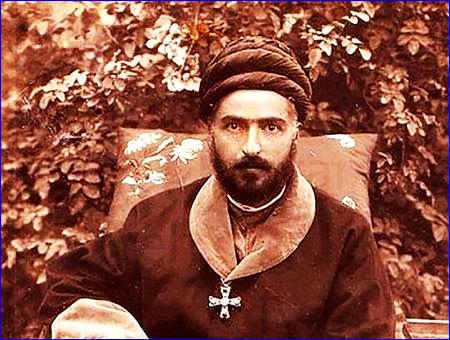
Assyrians Commemorate 100th Anniversary of Patriarch’s Assassination

His Holiness Benjamin Shimun XXI (1887-1918), Patriarch of the Holy Apostolic Catholic Assyrian Church of East.
AINA – 5/3/18
(AINA) — On March 3 Assyrian around the world commemorated the 100th anniversary of the martyrdom of Mar Benjamin Shimun XXI, Patriarch of the Church of East. Mar Shimun was assassinated on March 3rd, 1918 by Ismail Simko, a Kurdish warlord. The Patriarch had accepted Simko’s invitation and had gone to his residence in Kohnashaher (Persia) to negotiate for peace. According to historical sources, the Patriarch was accompanied by his military leaders, advisors and four Russian officers [1]; all were killed. The assassination unleashed punitive action by Assyrian troops who attacked Simko’s residence, but he managed to escape with his men to Khoi, where they took part in a massacre against Assyrians [2].
Related: Assyrians, Kurds and Ottomans
When the First Word War began in 1914, Turkey joined Germany and Austria against Britain, France and Russia. Jihad was declared against the Christian population living in the Ottoman Empire — the Assyrians, Armenians and Greeks. The majority of the Kurds, who are Muslims, followed the call to Jihad, accepted conscription and served in the Ottoman armed forces. In addition, from the outset of the war, the Young Turks leadership created the Special Organization (Teshkilati Mahsusa) units by enrolling criminals released from prison and providing them explosives, rifles and other military equipment. These paramilitary groups, led mostly by Kurdish chieftains, were mostly responsible for the murder of the Assyrian, Greek and Armenian populations in the Eastern provinces of the Ottoman state. The pogrom was systematic and planned by Turkey and has been recognized by prominant scholars and by a number of national parliaments as the first genocide of the 20th century.
Related: The Assyrian Genocide
Mar Benyamin Shimun was born in 1887 in Qudshanis, Turkey. His father’s name was Eshai, a member of the Patriarchal family, and his mother’s name was Asyat, the daughter of Qambar of Eill. He was consecrated to the rank of Metropolitan on March 1, 1903 by Patriarch Mar Rueil Shimun (1861–1903). Two weeks later Patriarch Rueil passed away, and by a unanimous decision taken by the Church hierarchy Mar Benyamin was consecrated as the Catholicos Patriarch of the Church on March 30, 1903, by His Beatitude Mar Ishaq Khnaneeshoo, Metropolitan of Rustaga, Shamisdin. The ceremony took place at the Church of Mar Shaleeta, an ancient Cathedral Church built in 1689 during the Patriarchate of Mar Shimun Dinkha, Catholicos Patriarch of the East [3].
Unlike other Patriarchs of oriental Christian Churches, Patriarch Mar Benjamin Shimun XXI served as the temporal leader of the Eastern Assyrians and played an important role as the supreme arbiter over the social and tribal structure of the Eastern Assyrians [4], in which maliks (chieftains), as the head of each tribe, played an important role. While attentive to their general interests, he maintained religious authority. The Patriarch was a hindrance to the strategy of Talaat Pasha, the Turkish Minister of Interior and later Grand Vizir, who not only wanted to deport the Assyrians from the Hakkari region, but sought eliminate them physically and destroy their identity. The Assyrians in the Hakkari and Urmia region were also seen as an obstacle to an emerging nationalist pan-Kurdish agenda as well.
Related: Brief History of Assyrians
The willingness and active role of the Kurds in the Assyrian genocide and the assasination of the Patriarch has fueled tensions and mistrust between Assyrians and Kurds to this day. The position of most Assyrian organizations, that Kurdish leaders are generally untrustworthy, stems from the Kurds honoring Ismail Simko as national hero, with complete disregard of his involvement in the treacherous murder of the Assyrian Patriarch in 1918. Even before the assassination Simko was, during World War I, involved in the persecution of Eastern Assyrians in the Urmi, Iran region. According to O’Shea 1,000 Christians were killed in Salmas, in a massacre instigated by Simko [5].
This lack of self-reproach by the Kurds was again evident in Autumn 2013, when Kurdish authorities of the city of Erbil in northern Iraq named a street after Simko Shikak. (LINK http://www.ankawa.com/). While there were some Kurdish critics of this action, it is clear that the majority of them choose not to confront the seamy aspects of their own history, even as they sought acceptance as democratic members of the global community. Kurds confronting honestly their own history would be an important step in establishing trust in order for the Assyrians to continue live with the Kurds side-by-side in Turkey, Iraq and Syria of today, and collaborate on building secular societies based on mutual respect, democracy and human rights.
Taner Akcam, professor of history at Clark University and a renowned Turkish genocide scholar, gives three reasons in particular why facing history is important. First, “to respect the victims, to accept their dignity and even contribute to end their trauma.” Second, “to enable reconciliation in a society, which values the democracy and human rights. A society that cannot face its own history cannot claim to establish democracy.” Third, relating to the second aspect; “if you want to state “never again”, it can only be possible, if society faces its own history. If a society does not acknowledge its wrongdoing, there is a potential danger that it will repeat it.”
Notes:
[1] Yonan, Gabriele. Assyrians Today, Society for Endangered People, Götingen, 1978, p. 35
[2] Joseph, John. The Modern Assyrians of the Middle East: Encounters With Western Christian Missions, Archaeologists, and Colonial Power, Brill, 2000. p. 147
[3] Solhkhah, Norman (Ed.). The Assyrian Martyr — Mar Benjamin Shimun Patriarch of The Church of the East, Center for the Assyrian Genocide Studies, Chicago, IL, 2008
[4] Yacoub, Joseph. Year of the Sword — The Assyrian Christian Genocide. A History. Hurst & Company, London, 2017, p.162
[5] O’Shea, Maria T. Trapped Between the Map and Reality: Geography and Perceptions of Kurdistan, Routledge, 2004. p. 100
© Assyrian International News Agency.
